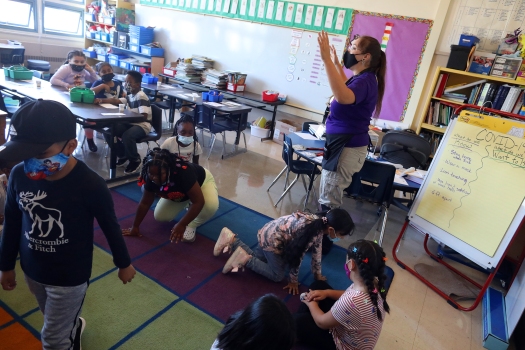OAKLAND — Two-thousand people logged into a virtual school board meeting that lasted until 3 a.m. Tuesday, during which Oakland Unified School District leaders presented a proposal to close, merge or truncate 15 schools as an attempt to right-size the district’s financial shortfalls.
Dozens of parents and teachers who were able to call into the meeting Monday expressed the anger, shock and sadness that has permeated the issue since a draft list of schools slated for closure was made public last week.
While the board won’t vote on the school closures until Feb. 8, the schools that were proposed for closure by the district before next school year are Prescott Elementary, Carl B. Munck Elementary, Parker K-8 School, Brookfield Elementary, Grass Valley Elementary and Community Day School.
The district next year would merge RISE Elementary with New Highland Elementary, Westlake Middle School with West Oakland Middle School, and Ralph J. Bunche High School with Dewey High School. The officials also proposed to shrink La Escuelita by closing down its middle school grades 6-8 and keeping it only an elementary school.
The following school year, the district proposes closing Horace Mann Elementary and Korematsu Discovery Academy, merging Manzanita Community School and Fruitvale Elementary, and closing grades 6 through 8 at Hillcrest School.
The students most affected by the closures are Black and Latino, according to the demographic information provided by the district.
“This is not easy for me to present this information, especially knowing that African American students and families will be the most affected by these recommendations,” said district Superintendent Kyla Johnson-Trammell. “At the same time, we must be just as honest about the challenges we’re facing as a school district.”
Oakland Unified runs 80 schools for 33,000 students — higher than others in California, according to the district and its consultants who presented at Monday’s meeting. San Jose Unified, for instance, operates 42 schools for roughly 27,000 students.
The district is projecting deficits in its general fund of $12.3 million for next fiscal year and $7.1 million for the 2023-24 fiscal year. It also is in need of $3.2 billion worth of repairs to its facilities, which it has largely deferred in order to patch up budget shortfalls elsewhere, like paying staff to operate the schools.
Enrollment in Oakland’s elementary schools varies widely, from a low of 110 to more than 700. The district estimates that next year, there will be 19 elementary schools with fewer than 304 students, which is its stated threshold for a school to be fiscally “sustainable.”
Johnson-Trammel told the board and the public during the meeting Monday that the district has continued to shift money around and use one-time funds to cover its budget shortfalls. Closing schools, she said, would allow the district to more deeply invest in a smaller number of schools by paying staff better, fixing school infrastructure and developing more programming for students.
But many parents, teachers and others are skeptical that the school closures will be the saving grace the district needs.
The projections from the district’s financial consultants presented Monday estimate that the savings from the closures and mergers would range from about $4 million to close to $15 million. Oakland Unified’s budget is close to $700 million.
“All this misery and heartache for 2.1% is really appalling,” one Prescott Elementary parent, Stefanie Parrott, of the proposed savings by closing schools.
The board voted last week to cut $40 million from its budget through layoffs, cutting staff vacancies and other measures in a separate move from the school closures. For some critics of school closures, like District 5 school board director Mike Hutchinson, that was enough to deal with the district’s financial woes.
The district is facing pressure from the state, which ruled in December that that Alameda County could intervene in Oakland Unified’s budget process after school board rejected an option of closing schools last fall. Alameda County Superintendent of Schools L.K. Monroe had warned Oakland school board members in November she was concerned about the district’s reliance on one-time revenues to stay afloat instead of making the deep funding cuts needed. If the district did not cooperate, Monroe said the county could withhold the pay of school board members and superintendent Johnson-Trammell.
While the board had voted previously to appeal the state ruling, they directed the district administration in early January to go ahead with crafting the school closure list. The district officially notified the impacted families last week, and the vote by the board will be taken next week, on Feb. 8.
Many people have criticized the district and board for the rapid time frame they are considering the closures and implored them to put off the vote until later in the year, to host more public meetings and hear from the community.
District officials pointed out that students attending schools that are being closed will receive top priority to choose other schools in the district to attend, but that process needs to happen soon.
Still, the disruption in being displaced weighs heavily on the affected families, particular through the pandemic.
Oakland resident Carl Pezold said his son, who is 8 and is enrolled in a special education program at Carl B. Munck Elementary, has been to three elementary schools prior to Carl Munck.
He aged out at a couple programs, and others weren’t a good fit. The disruption of transferring schools and trying to find one that is a good fit for his nonverbal son has been hard on his family.
“We saw his development start going backwards,” Pezold said in an interview of the multiple transfers. “It was a lot of stress.”
Carl B. Munck Elementary has been wonderful, however. Now, it’s on the list of schools that the district will close, which came as a shock to Pezold and his family.
“What they’re doing is really high quality,” he said of Carl Munck’s special education programs. “The entire school embraces the special needs kids. … The teachers and staff know the kids names. They know my son’s name. They’ve instructed the students to know my son’s name; so here’s this nonverbal kid that’s being greeted by his fellow students.
“I don’t see it in stores, in other places. But it happens in our school there,” Pezold said. “The idea we’re at risk of losing that is bad for my family, but it’s also bad for this group of little ambassadors because that’s what they’re being taught at this school.”
Pezold understands that the district needs to find the right formula to be fiscally solvent. He doesn’t expect that there will be no closures. But he’s one of many parents who are imploring the district to engage further with the community to find a solution that won’t be so disruptive.
“We’ve got to slow down the process.”


















